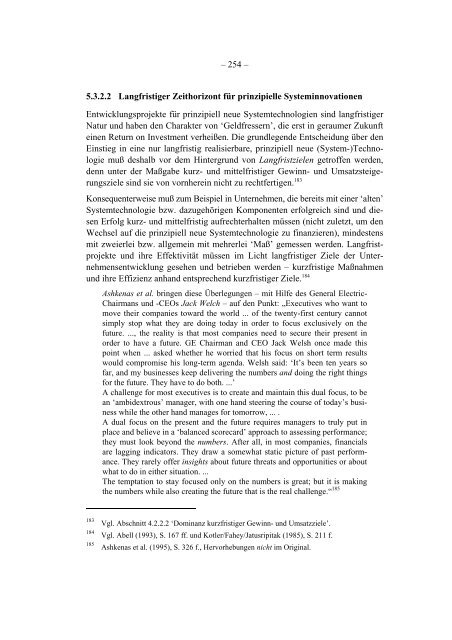Initiierung technologischer Systeminnovationen - OPUS - Universität ...
Initiierung technologischer Systeminnovationen - OPUS - Universität ...
Initiierung technologischer Systeminnovationen - OPUS - Universität ...
Erfolgreiche ePaper selbst erstellen
Machen Sie aus Ihren PDF Publikationen ein blätterbares Flipbook mit unserer einzigartigen Google optimierten e-Paper Software.
– 254 –<br />
5.3.2.2 Langfristiger Zeithorizont für prinzipielle <strong>Systeminnovationen</strong><br />
Entwicklungsprojekte für prinzipiell neue Systemtechnologien sind langfristiger<br />
Natur und haben den Charakter von ‘Geldfressern’, die erst in geraumer Zukunft<br />
einen Return on Investment verheißen. Die grundlegende Entscheidung über den<br />
Einstieg in eine nur langfristig realisierbare, prinzipiell neue (System-)Technologie<br />
muß deshalb vor dem Hintergrund von Langfristzielen getroffen werden,<br />
denn unter der Maßgabe kurz- und mittelfristiger Gewinn- und Umsatzsteigerungsziele<br />
sind sie von vornherein nicht zu rechtfertigen. 183<br />
Konsequenterweise muß zum Beispiel in Unternehmen, die bereits mit einer ‘alten’<br />
Systemtechnologie bzw. dazugehörigen Komponenten erfolgreich sind und diesen<br />
Erfolg kurz- und mittelfristig aufrechterhalten müssen (nicht zuletzt, um den<br />
Wechsel auf die prinzipiell neue Systemtechnologie zu finanzieren), mindestens<br />
mit zweierlei bzw. allgemein mit mehrerlei ‘Maß’ gemessen werden. Langfristprojekte<br />
und ihre Effektivität müssen im Licht langfristiger Ziele der Unternehmensentwicklung<br />
gesehen und betrieben werden – kurzfristige Maßnahmen<br />
und ihre Effizienz anhand entsprechend kurzfristiger Ziele. 184<br />
Ashkenas et al. bringen diese Überlegungen – mit Hilfe des General Electric-<br />
Chairmans und -CEOs Jack Welch – auf den Punkt: „Executives who want to<br />
move their companies toward the world ... of the twenty-first century cannot<br />
simply stop what they are doing today in order to focus exclusively on the<br />
future. ..., the reality is that most companies need to secure their present in<br />
order to have a future. GE Chairman and CEO Jack Welsh once made this<br />
point when ... asked whether he worried that his focus on short term results<br />
would compromise his long-term agenda. Welsh said: ‘It’s been ten years so<br />
far, and my businesses keep delivering the numbers and doing the right things<br />
for the future. They have to do both. ...’<br />
A challenge for most executives is to create and maintain this dual focus, to be<br />
an ‘ambidextrous’ manager, with one hand steering the course of today’s business<br />
while the other hand manages for tomorrow, ... .<br />
A dual focus on the present and the future requires managers to truly put in<br />
place and believe in a ‘balanced scorecard’ approach to assessing performance;<br />
they must look beyond the numbers. After all, in most companies, financials<br />
are lagging indicators. They draw a somewhat static picture of past performance.<br />
They rarely offer insights about future threats and opportunities or about<br />
what to do in either situation. ...<br />
The temptation to stay focused only on the numbers is great; but it is making<br />
the numbers while also creating the future that is the real challenge.“ 185<br />
183 Vgl. Abschnitt 4.2.2.2 ‘Dominanz kurzfristiger Gewinn- und Umsatzziele’.<br />
184 Vgl. Abell (1993), S. 167 ff. und Kotler/Fahey/Jatusripitak (1985), S. 211 f.<br />
185 Ashkenas et al. (1995), S. 326 f., Hervorhebungen nicht im Original.

















